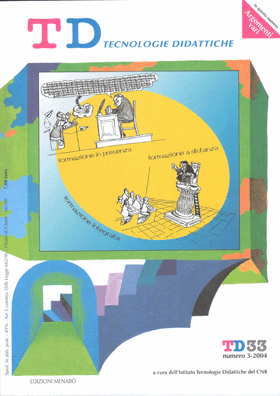Education and learning appropriate for each type of class
Main Article Content
Abstract
Article Details
Section
Authors who publish with this journal agree to the following terms:
- Authors retain copyright and grant the journal right of first publication with the work simultaneously licensed under a Creative Commons CC BY 4.0 Attribution 4.0 International License.
- Authors are able to enter into separate, additional contractual arrangements for the non-exclusive distribution of the journal's published version of the work (e.g., post it to an institutional repository or publish it in a book), with an acknowledgement of its initial publication in this journal.
- Authors are permitted and encouraged to post their work online (e.g., in institutional repositories or on their website) prior to and during the submission process, as it can lead to productive exchanges, as well as earlier and greater citation of published work (See The Effect of Open Access)
References
Ajello A., (1999), La motivazione alla competenza, in Pontecorvo C., Manuale di psicologia dell’educazione, Il Mulino, Bologna.
Ajello A., Pontecorvo C., Zucchermaglio C., (1999), Discutendo si impara, Carocci Editore, Roma.
Bandura A., (1977), Social Learning Theory, Prentice Hall, Englewood Cliffs, n.j.
Bandura A., (1995), Self-efficay in changing societies, Cambrifge Univesity Press, Cambridge, trad. it. Il senso di autoefficacia, Edizioni Centro Studi Erickson, Trento.
D. W. Johnson, R.T. Johnson ,(1992), Learning Together and Alone, Prentice Hall ,Englewood Cliff, N.J.
Gordon T., (1974), Teacher Effectivness Training, Peter Weiden, N.Y.
Iversen G. R., (1991) Contextual analysis, Sage University Press, Newbury Park.
Klein J. (1956), The study of groups, Routeledge & Kegan, N.Y., trad. It (1968), Sociologia dei gruppi, Einaudi, Torino.
Jeffreys-Duden, K., (1999), Das Streitschlichter-Programm, Beltz Verlag, Weinheim und Basel, trad. it., (2001), Mediatori efficaci, La Meridina, Bari.
Johnson, D. W. Johnson, R. T. & Holubec, E. J. (1994). Cooperative Learning in the classroom, ASCD, Alexandria, VA, trad. it. (1997), Johnson, E. W., Johnson, R. T., & Holubec, L’appendimento cooperativo, Erickson, Trento. Johnson, D. W., Johnson, R. T., (1998), Cooperative Learning and social interdependence theory. In R. S. Tindale, L. Heath, J. Edwards, E. J. Posavac, F. B. Bryant, Y. Suarez-Balcazar, E. Henderson-King, & J. Myers (Eds.), Theory and research on small groups. (pp. 9-35), Plenum, N.Y.
Johnson, D. W., Johnson, R. T., (1999), Learning together and alone. Cooperative, competitive, and individualistic learning, 5th ed, Allyn & Bacon, Boston, MA.
Kagan, S. (1994), Cooperative Learning, Kagan Cooperative Learning, San Juan Capistrano. Kagan S. & Kagan M., (1994), The Structural Approach, in S. Sharan, Handbook of Cooperative Learning Methods, GreenWood Press, Westport, CT.
Masini V. , (1996), Dalla Classe al Gruppo, Provveditorato agli Studi di Terni, Terni.
Masini V., (2000), Dalle emozioni ai sentimenti, Prevenire è Possibile Editore, Caltagirone.
Masini V. (2002), La qualità educativa, relazionale e dell’apprendimento nella scuola, Prevenire è Possibile Editore, Isernia.
Mehan H. (1979), Learning lessons: Social organization in the classroom, Harvard University Press, Cambridge.
Pontecorvo C. (1975), Analisi del processo didattico, La Scuola, Brescia.
Pontecorvo C. (1999), Manuale di psicologia dell’educazione, Il Mulino, Bologna.
Presutti F., (1993), Analisi psicologica delle dinamiche relazionali e della strutturazione dei ruoli nella classe, Quaderni di “Innovazione Scuola”, IRRSAE, Ancona.
Sharan S. et alii, (1984), Cooperative Learning in The Classroom: Research in Disaggregated Schools, Erlbaum, Hillsdale, N.J.
Sharan, Y. (1998). Gli alunni fanno ricerca. L’apprendimento in gruppi cooperativi, Erickson, Trento.
Searle S.R., Casella G., McColluch C. E., (1992), Variance components, Wiley, New York.
Sinclair J.M., Coulthard R.M., (1975), Towards an analysis of discourse: The English used by teachers and pupils, Oxford University Press, London.
Slavin, R. E., (1996), Education for all., Swets & Zeitlinger Publishers, Lisse.
Slavin, R. E., Madden, N. A., Dolan, L. J., Wasik. B.A. (1996). Every child, Every school. Success for all., Corwin Press, Thousand Oaks, CA.

